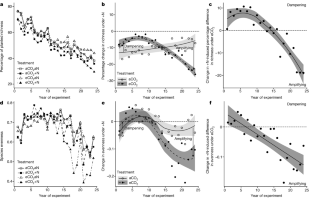2024-10-16 ミシガン大学
<関連情報>
- https://news.umich.edu/nitrogen-pollution-and-rising-carbon-dioxide-a-joint-threat-to-grassland-biodiversity/
- https://www.nature.com/articles/s41586-024-08066-9
高CO2は24年間にわたり窒素による多様性の損失を減衰させ、その後増幅させる High CO2 dampens then amplifies N-induced diversity loss over 24 years
Peter B. Reich,Neha Mohanbabu,Forest Isbell,Sarah E. Hobbie & Ethan E. Butler
Nature Published:16 October 2024
DOI:https://doi.org/10.1038/s41586-024-08066-9

Abstract
Rising levels of atmospheric carbon dioxide (CO2) and nitrogen (N) deposition affect plant communities in numerous ways1,2,3,4,5,6,7,8,9,10,11. Nitrogen deposition causes local biodiversity loss globally12,13,14, but whether, and if so how, rising CO2 concentrations amplify or dampen those losses remains unclear and is almost entirely unstudied. We addressed this knowledge gap with an open-air experiment in which 108 grassland plots were grown for 24 years under different CO2 and N regimes. We initially found that adding N reduced plant species richness less at elevated than at ambient CO2. Over time, however, this interaction reversed, and elevated CO2 amplified losses in diversity from enriched N, tripling reductions in species richness from N addition over the last eight years of the study. These interactions resulted from temporal changes in the drivers of diversity, especially light availability, that were in turn driven by CO2 and N inputs and associated changes in plant biomass. This mechanism is likely to be similar in many grasslands, because additions of the plant resources CO2 and N are likely to increase the abundance of the dominant species. If rising CO2 generally exacerbates the widespread negative impacts of N deposition on plant diversity, this bodes poorly for the conservation of grassland biodiversity worldwide.



